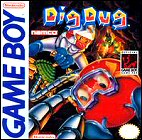
 The Game: You are Dig Dug, an intrepid gardener whose soil is infested with pesky Pookas and fire-breathing Fygars. You’re armed with your trusty pump, which you can use to inflate your enemies until, finally, they blow up. But both the Pookas and Fygars can crawl through the ground and can pop out into your tunnels, and if a Fygar sneaks up behind you, he can toast you if you’re not careful. In New Dig Dug, you guide Dig on a series of subterranean adventures, trying to unlock buried doors by finding some equally buried keys. Pookas and Fygars still stalk the underground tunnels in the new game, only each one that Dig dispatches is replaced by a new Pooka or Fygar from above. (Namco, 1992)
The Game: You are Dig Dug, an intrepid gardener whose soil is infested with pesky Pookas and fire-breathing Fygars. You’re armed with your trusty pump, which you can use to inflate your enemies until, finally, they blow up. But both the Pookas and Fygars can crawl through the ground and can pop out into your tunnels, and if a Fygar sneaks up behind you, he can toast you if you’re not careful. In New Dig Dug, you guide Dig on a series of subterranean adventures, trying to unlock buried doors by finding some equally buried keys. Pookas and Fygars still stalk the underground tunnels in the new game, only each one that Dig dispatches is replaced by a new Pooka or Fygar from above. (Namco, 1992)
Memories: Okay, so we’ve got arcade-quality Dig Dug on the Game Boy Advance thanks to Namco Museum. But I thought it’d be fun to go back and revisit the original monochrome Game Boy version of Dig Dug to see how close it was to the arcade game. And the answer is…well, not very.
 The original Game Boy Dig Dug may sound like the real thing, but in terms of how it looks and plays, it’s about as close to the mark as, say, Dig Dug on the Atari 2600. In the original, and even in the Namco Museum versions and the Namco 5-in-1 TV Game, the thickness of the walls dividing the tunnels provides some clues as to whether you can pump through them and safely do away with an enemy on the other side, for example. Here, that valuable clue just isn’t provided, and it’ll cost you if you count on it.
The original Game Boy Dig Dug may sound like the real thing, but in terms of how it looks and plays, it’s about as close to the mark as, say, Dig Dug on the Atari 2600. In the original, and even in the Namco Museum versions and the Namco 5-in-1 TV Game, the thickness of the walls dividing the tunnels provides some clues as to whether you can pump through them and safely do away with an enemy on the other side, for example. Here, that valuable clue just isn’t provided, and it’ll cost you if you count on it.
 Most of the effort seems to have gone into New Dig Dug, a quest-style remake which applies some Mario-era conventions and a few cunning puzzles to standard Dig Dug-style game play. The levels are cleverly designed, there’s a survivable learning curve as new elements are introduced, and it’s a lot of fun. Some of those new elements include rolling boulders that zip down already-excavated pathways and flatten everything in their path – including Dig Dug – before you can even say
Most of the effort seems to have gone into New Dig Dug, a quest-style remake which applies some Mario-era conventions and a few cunning puzzles to standard Dig Dug-style game play. The levels are cleverly designed, there’s a survivable learning curve as new elements are introduced, and it’s a lot of fun. Some of those new elements include rolling boulders that zip down already-excavated pathways and flatten everything in their path – including Dig Dug – before you can even say  “Indiana Jones,” Monty Python-inspired 16
“Indiana Jones,” Monty Python-inspired 16  ton weights, and so on. It’s a perfect balance between what we already know about playing Dig Dug and a completely new game – despite suffering from some of the same limitations as the translation of the original.
ton weights, and so on. It’s a perfect balance between what we already know about playing Dig Dug and a completely new game – despite suffering from some of the same limitations as the translation of the original.
 using WordPress and
using WordPress and